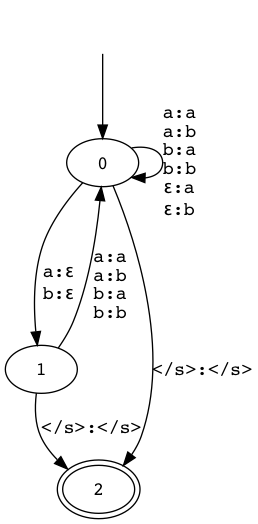Setup
Clone the Homework 2 repository. It contains the following files:
fst.py | Module for finite transducers |
cer.py | Module for evaluation |
train.old | Training data in original spelling |
train.new | Training data in modern spelling |
test.old | Test data in original spelling |
test.new | Test data in modern spelling |
The data is the text of Hamlet from Shakespeare's First Folio in original and modern English spelling. The training data is everything up to where Hamlet dies (spoiler alert) and the test data is the last 50 or so lines afterwards.
The fst module contains a FST class and associated functions that should be extremely helpful for this assignment. If you're writing in a language other than Python, please talk to the instructor about getting equivalent help in your programming language.
In the following, point values are written after each requirement, like this.30
1. Building blocks
- Construct a weighted FST $M_{\text{LM}}$ for a bigram language model for modern English and train it on
train.new.1 Thefstmodule provides code for this: just usefst.make_ngram(open("train.new")). - Write code to construct an unweighted FST $M_{\text{TM}}$ that transforms strings over the modern alphabet into strings over the original alphabet.5 It should allow substitutions, insertions, and deletions as discussed in class. Use the provided
FSTclass. You can use the methodFST.visualize()to view your FST and make sure that it looks something like this (shown here for a two-letter alphabet): Yours should be able to input any character found in
Yours should be able to input any character found in train.newand output any character found intrain.old. - Write code that takes a string $w$ and creates an unweighted FST $M_w$ that inputs just $w \texttt{</s>}$ and outputs just $w \texttt{</s>}$.1 Again, you can use
FST.visualize()to check your results.
2. Decoding
- Initialize the probabilities of $M_{\text{TM}}$. Since we know that most letters in original spelling stay the same in modern spelling, give transitions on $a:a$ more probability (like 100 times more); this makes it easier to know if your decoder is working. Call the
FST.normalize_cond()method to ensure that probabilities correctly sum to one. Briefly describe your initialization.1 - For each original line $w$ in the test set, use
fst.compose()to compose $M_{\text{LM}}$, $M_{\text{TM}}$, and $M_w$.1 - Implement the Viterbi algorithm to find the best path through this FST.5 Be sure to visit the states in the correct order!
- Run it on
test.old. For the first ten lines, report the best modernization together with its log-probability:[Horatio] Now cracke a Noble heart. -108.6678162110888 Good ight sweet Prince, -85.19153221166528
and so on.1 - Use the
cermodule to evaluate how well your modernizer works. You can either callcer.cer()directly as a function, or runcer.py test.new youroutput.newwhereyouroutput.newis a file containing your outputs. (Don't forget to remove the log-probabilities.) Report your score.1 A lower score is better; if you initialize the model well, you should get a score under 10%.1
3. Training
Now we'll improve our modernizer by training the model using hard EM. We'll train on parallel text rather than on nonparallel text as in class; it's faster this way and gives better results.
- Implement the E step: For each line in the training data, consisting of a modern string $m$ and an original string $e$,
- Compose $M_m$, $M_{\text{TM}}$, and $M_e$.1 Note that this is different from Part 2.
- Use the Viterbi algorithm to find the best path through the composed transducer.1
- In FST composition, every transition simulates a transition of one or both of the composed FSTs. Keep a global count of how many times each of the transitions of $M_{\text{TM}}$ is thus simulated.5 Tip: Every time
fst.compose()creates a transition, it stores the transitions it simulates in thecomposed_fromattribute.
- Implement the (rest of the) M step: Renormalize the counts collected above to reestimate the transition probabilities of $M_{\text{TM}}$.1 It's pretty important to apply some add-$\delta$ smoothing at this point. The method
FST.normalize_cond()takes an optional parameteraddthat lets you do this. - Repeat the above steps for a few iterations. After each iteration,
- Decode
test.oldand measure your score againsttest.new. Report your score.1 It should eventually get better than 7.5%.1 - Print your outputs for the first ten lines.1
- Print the probabilities of all transition weights greater than or equal to 0.1.1
- Decode
- Briefly describe what you saw your model learn.1
Submission
Please submit all of the following in a gzipped tar archive (.tar.gz or .tgz; not .zip or .rar) via Sakai:
- A PDF file (not .doc or .docx) with your responses to the instructions/questions above.
- All of the code that you wrote.
- A README file with instructions on how to build and run your code on
student*.cse.nd.edu. If this is not possible, please discuss with the instructor before submitting.